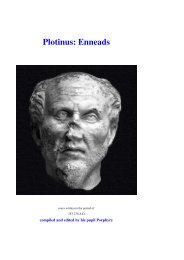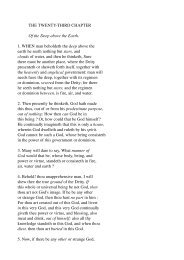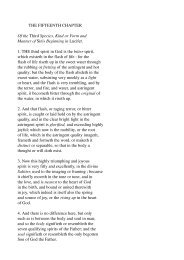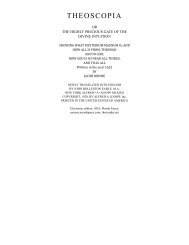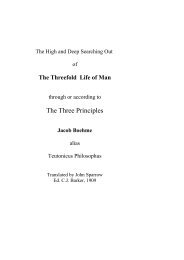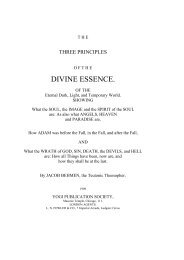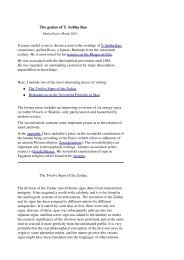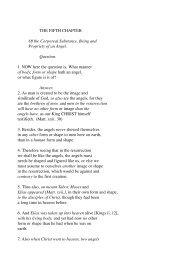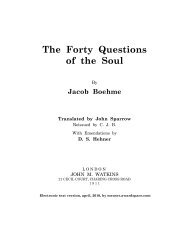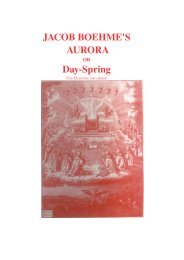Gerald Massey's Lectures - Society in evolution - Awardspace
Gerald Massey's Lectures - Society in evolution - Awardspace
Gerald Massey's Lectures - Society in evolution - Awardspace
Create successful ePaper yourself
Turn your PDF publications into a flip-book with our unique Google optimized e-Paper software.
who drives the darkness out of or away from the lunar orb, and does all the damage he<br />
can to the Typhonian powers, or Philist<strong>in</strong>es, the story-teller multiplies the jackal to<br />
enhance the triumph of his hero; and <strong>in</strong>stead of the struggle between Horus and the<br />
jackal-headed Sut-Anup, we have the more difficult feat of catch<strong>in</strong>g 300 jackals and<br />
sett<strong>in</strong>g fire to their tails, so that they might consume the crops of the Philist<strong>in</strong>es, or, <strong>in</strong><br />
other words, burn out the darkness from the orb of the moon.<br />
It is probable that Mithra, son of Ahura Mazda, and natural opponent of the dark Power,<br />
is the same representative of the God of Light, reflected <strong>in</strong> the moon as the witness by<br />
night for the absent sun. It may be noted that Matra <strong>in</strong> Egyptian means the Witness, or<br />
more fully, the Witness for Ra. The scene pourtrayed on the Persian monuments is<br />
nocturnal, and the time of year is that of the sun's entrance <strong>in</strong>to the sign of Scorpio, where<br />
it is deprived of its virility. At this time the moon rises at full <strong>in</strong> the sign of the Bull, the<br />
first of the superior signs. The Lord of Light <strong>in</strong> the moon is now the dom<strong>in</strong>at<strong>in</strong>g power<br />
dur<strong>in</strong>g six months. Thus Mithras slay<strong>in</strong>g the Bull is equivalent to Samson kill<strong>in</strong>g the<br />
Lion, or overcom<strong>in</strong>g the fierceness of the Solar fire; and also of Osiris do<strong>in</strong>g battle with<br />
Sut-Typhon and conquer<strong>in</strong>g his terrors <strong>in</strong> external phenomena. Osiris dies on the 17th of<br />
the month Athor, which was at the time of the Autumn Equ<strong>in</strong>ox, or rather he enters the<br />
six lower signs at that time. An ark was made <strong>in</strong> the shape of a crescent moon, and on the<br />
19th of the same month the priests proclaimed that Osiris was found, his resurrection on<br />
the third day be<strong>in</strong>g <strong>in</strong> the moon. Thus it was <strong>in</strong> the new moon that the Dead Osiris first<br />
returned to life <strong>in</strong> the form of his own son.<br />
Our modern solarite <strong>in</strong>terpreters can talk of little else but the sun, the dawn, and the dark.<br />
Mr. Renouf, <strong>in</strong> his Hibbert lectures, identifies Sut-Anubis with the twilight, or as the<br />
dusk. Hence, when it is said <strong>in</strong> the texts that he "swallowed his father Osiris," this on the<br />
face of it looks like the darkness of night swallow<strong>in</strong>g the disappear<strong>in</strong>g sun. But Egyptian<br />
mythology is by no means so simple as that. It is not to be fathomed on the face of it, nor<br />
can it be <strong>in</strong>terpreted without such a knowledge of the total typology, as the Aryan School<br />
all put together do not possess. There is noth<strong>in</strong>g simply solar <strong>in</strong> it anywhere! It is true that<br />
Sut represents the presence and the power of darkness. It is true that the nocturnal sun <strong>in</strong><br />
the under world was called Osiris, or Atum, or Amen-Ra. Also, the sett<strong>in</strong>g orbs of light<br />
were represented as be<strong>in</strong>g swallowed down by the crocodile or some other type of the<br />
devourer. But the cont<strong>in</strong>ual conflict and alternate victory of light and darkness were seen<br />
to have their most obvious, most visible, most <strong>in</strong>terest<strong>in</strong>g field of battle <strong>in</strong> the moon! It<br />
was there the watchers observed the never-ceas<strong>in</strong>g struggle for the birth-right of the tw<strong>in</strong><br />
brothers, who personated the oppos<strong>in</strong>g powers. The dark one was first born from the<br />
mother moon at full; but the light one was acknowledged to be the genu<strong>in</strong>e heir-apparent!<br />
There is a myth of the bl<strong>in</strong>d Horus <strong>in</strong> which he is described as sitt<strong>in</strong>g solitary <strong>in</strong> his<br />
darkness. Sut is said to have swallowed his eye, or to have wounded it, and put out the<br />
sight. In one text Horus says, "Behold, my eye is as though Sut (Anup) had pierced it." In<br />
another he cries, "I am Horus. I come to search for m<strong>in</strong>e eyes." Sut, who swallows the<br />
eye, is made to restore it aga<strong>in</strong>! In one account the eye is said to be restored at the dawn<br />
of day; that is <strong>in</strong> the vague stage of the conflict between the darkness and the light.<br />
At one time, says Plutarch, Sut smote Orus <strong>in</strong> the Eye; this represented the dim<strong>in</strong>ution of<br />
the moon. At another he plucked the eye out and swallowed it, afterwards giv<strong>in</strong>g it back<br />
to the sun. This bl<strong>in</strong>d<strong>in</strong>g denoted the Eclipse.<br />
In the lunar phase of the mythos the Eye of light, or of the sun, is the moon. The moon at<br />
full was the mirror of light, hence it was the mother of Horus as the child of light! But the<br />
eye was the primitive mirror. So the moon was called the Eye of the sun, when it was<br />
known as a reflector of the solar light. Thus the lunar orb was the consort of the sun; his<br />
Eye by night, as the reproducer of his light when he was <strong>in</strong> the under-world; and <strong>in</strong><br />
reproduc<strong>in</strong>g the light she was as the mother br<strong>in</strong>g<strong>in</strong>g forth his child! For <strong>in</strong>stance, the<br />
cow was a type of the moon as Hathor, or as Aahti, and when the cow is portrayed with



